Table Of Contents
<!-- Begin var ans = new Array; var done = new Array; var score = 0; ans\[1\] = "Output"; ans\[2\] = "Threshold"; ans\[3\] = "Control Voltage"; ans\[4\] = "Reset"; ans\[5\] = "To detect when the capacitor is HIGH"; ans\[6\] = "To discharge capacitor C"; ans\[7\] = "To detect when the capacitor is LOW"; ans\[8\] = "To reset the chip"; ans\[9\] = "In phase with each other"; ans\[10\] = "Detects the HIGH on capacitor C"; ans\[11\] = "Charge"; ans\[12\] = "Detects the LOW on capacitor C"; ans\[13\] = "HIGH"; ans\[14\] = "Decrease the value of capacitor C"; ans\[15\] = "It decreases"; ans\[16\] = "Discharges the capacitor C"; ans\[17\] = "The output frequency decreases"; ans\[18\] = "R2 only"; ans\[19\] = "No. It must go down to less than 0.7v"; ans\[20\] = "It goes HIGH"; ans\[21\] = "R2"; ans\[22\] = "500kHz"; ans\[23\] = "Greater than 50%"; ans\[24\] = "141Hz"; ans\[25\] = "Decrease"; ans\[26\] = "100k plus 33k"; ans\[27\] = "363 secs"; ans\[28\] = "100k 22k 10n"; ans\[29\] = "4k7 1k 1n"; ans\[30\] = "3M3 47u"; ans\[31\] = "Monostable"; ans\[32\] = "Trigger"; ans\[33\] = "(a)"; ans\[34\] = "(e)"; ans\[35\] = "(c)"; ans\[36\] = "Stay HIGH"; ans\[37\] = "No"; ans\[38\] = "The circuit will settle with the LED on"; ans\[39\] = "The circuit will settle with the LED off"; ans\[40\] = "The circuit will oscillate. Connecting to pin 3 is the same as pin 7"; function Try(question, answer) { if (answer != ans\[question\]) { if (!done\[question\]) { done\[question\] = -1; window1=window.open("", "NewWindow1", "toolbar=no,directories=no,menubar=no,scrollbars=no,top=475,left=25,width=320,height=20"); window1.document.writeln("<title>Answers to: 555 Timer QUESTIONS . . . . </title>"); window1.document.writeln("<font face=Arial size=2 color=#FF00cc><center>Wrong!\\n\\nYour score is now: " + score + "<font face=Arial size=2 color=#cc0000><center>The correct answer is: <font face=Arial size=2 color=#000000>" + ans\[question\]); } else { alert("You have already answered that question"); } } else { if (!done\[question\]) { done\[question\] = -1; score++; alert("Correct!\\n\\nYour score is now: " + score); } else { alert("You have already answered that question"); } } } function Assessment () { if (score >= 40) { alert("Perfect Score!"); } if (score >= 34 && score <= 39) { alert("Excellent Work - but not Perfect!") } if (score >= 0 && score <= 34) { alert("Your test results are not good enough. \\nRead the 555 article again.") } } // End var R1, R2, C, T1, T2, F, TD, RT; function Process(form) { if(R1<1 || C<.00005) alert ("R1 should be > 1k and C > .00005u"); if(R1>.99 && R2>0 && C>.00005) { RT = (R1\*1)+(R2\*1); T1 = 0.693 \* RT \* C; T1 = Math.round(T1\*100000); T1 = T1/100000; T2 = 0.693 \*R2 \* C; T2 = Math.round(T2\*100000); T2 = T2/100000; F = 1.44/(C\* ( (R1\*1)+(R2\*2) )); F = Math.round(F\*10000000); F = F/10000000; TD = (1.1 \* RT \* C)/1000; TD = Math.round(TD\*10000); TD = TD/10000; form.T1.value = T1; form.T2.value = T2; form.F.value = F; form.TD.value = TD; } } function SetR1(R) { R1 = R.value;} function SetR2(R) { R2 = R.value;} function SetC(CC) { C = CC.value; } function SetTD(R) { TD = R.value;} function ClearForm(form){ R1=0; R2=0; C=0; T1=0; T2=0; TD=0; F=0; form.R1.value=0; form.R2.value=0; form.C.value=0; form.T1.value=0; form.T2.value=0; form.F.value=0; form.TD.value=0; } // --->
555 TIMER TEST
How much do you know about
the 555 Timer IC?.
Take this test and find out …
[-by Colin Mitchell](mailto:colin@elechelp.com?Subject=Message to Colin Mitchell&Body=You can send a message to Colin Mitchell on any subject (electronics):)
Take this test both before and after reading the 555 article and compare your results.
This type of test is classified as OBJECTIVE or MULTIPLE-CHOICE. It is much more effective than it appears. Multiple-choice can be “off-putting” and decision-making is made more difficult. That’s why it is so good. In addition, it is very easy to have computer-scoring and provided enough questions are asked, the results are very accurate. Attempting this type of test will strengthen your knowledge of a topic. By the simple fact that it asks the same information more than once, with the result that the facts are passed to your long-term memory.
QUESTIONS:
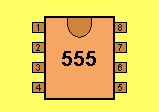
The function of Pin 3 is:
- Control Voltage
- Discharge
- Output
- Reset
- Threshold
- Trigger
The function of Pin 6 is:
- Control Voltage
- Discharge
- Output
- Reset
- Threshold
- Trigger
The function of Pin 5 is:
- Control Voltage
- Discharge
- Output
- Reset
- Threshold
- Trigger
The function of Pin 4 is:
- Control Voltage
- Discharge
- Output
- Reset
- Threshold
- Trigger
What is the function of the Threshold pin?
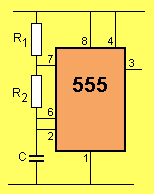 To charge the capacitor “C”
To discharge the capacitor “C”
To detect when the capacitor is “HIGH”
To detect when the capacitor is “LOW”
To charge the capacitor “C”
To discharge the capacitor “C”
To detect when the capacitor is “HIGH”
To detect when the capacitor is “LOW”What is the function of the Discharge pin?
- To charge the capacitor “C”
- To discharge capacitor “C”
- To detect when the capacitor is “HIGH”
- To detect when the capacitor is “LOW”
What is the function of the Trigger pin?
- To charge the capacitor “C”
- To discharge the capacitor “C”
- To detect when the capacitor is “HIGH”
- To detect when the capacitor is “LOW”
What is the function of the Reset pin?
- To discharge the capacitor “C”
- To reset the chip
- To make the output of the chip “HIGH”
The Discharge and Output are:
- In phase with each other
- Out of phase with each other
What does pin 6 do?
- Charges the capacitor “C”
- Discharges the capacitor “C”
- Detects the HIGH on capacitor “C”
- Detects the LOW on capacitor “C”
When pin 2 detects the voltage-level on the capacitor, does the capacitor begin to charge or discharge?
- Charge
- Discharge
What does pin 2 do?
- Charges the capacitor “C”
- Discharges the capacitor “C”
- Detects the HIGH on capacitor “C”
- Detects the LOW on capacitor “C”
In the following diagram, is the output predominantly HIGH or LOW? Remember: Pin 7 and 3 act “in harmony”
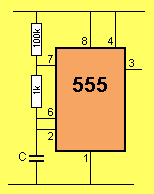 HIGH
LOW
HIGH
LOWTo increase the output frequency of a 555:
- Increase the value of capacitor “C”
- Decrease the value of capacitor “C”
If the resistors in Q13 are swapped, does the output frequency change?
- It increases
- It decreases
- Little or no effect
What does pin 7 do?
- Charges the capacitor “C”
- Discharges the capacitor “C”
- Detects the HIGH on capacitor “C”
- Detects the LOW on capacitor “C”
If the value of R1 is increased:
 The output frequency increases
The output frequency decreases * The overall frequency does not alter
The output frequency increases
The output frequency decreases * The overall frequency does not alterName the resistor(s) that effect the timing of the “LOW” OUTPUT”:
- R1 and R2
- R1 only
- R2 only
For a 5v circuit, if pin 4 is taken to 1v, does the chip reset?
- Yes
- No
- Cannot be determined
When pin 2 detects the voltage-level on the capacitor, what happens to the output?
- It goes HIGH
- It goes LOW
For the following diagram, which resistor(s) controls the “SPACE:”
 R1
R2 * R1 + R2
R1
R2 * R1 + R2The maximum frequency of operation for a 555 is:
- 100kHz
- 500kHz
- 5MHz
- 500Hz
For the following diagram, the Mark:Space ratio will be:
 Greater than 50%
Less than 50%
Equal
Unable to be determined
Greater than 50%
Less than 50%
Equal
Unable to be determined
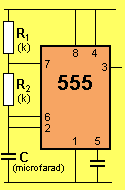
Output HIGH (mS)

Output LOW (mS)
Frequency (kHz)
Calculate the Frequency, HIGH-interval and LOW-interval
for a 555 in ASTABLE mode. See answer below for Monostable (Delay):
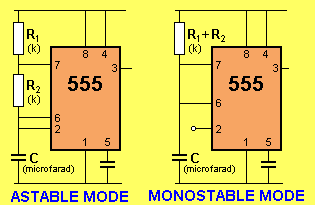

Delay Sec

Use the calculator above to obtain the output frequency of the following circuit:
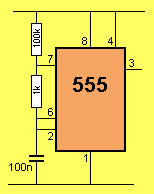 0.0001412kHz
141Hz * 141kHz
0.0001412kHz
141Hz * 141kHzIf the two resistors in Q24 are swapped, the output frequency will:
- Increase
- Decrease
- Remain the same
What value resistors with a 100u, will produce a delay of 15 seconds?
- 100k plus 33k
- 47k plus 47k
- 22k plus 33k
What value of delay will 3M3 and 100u produce?:
- 0.47 sec
- 3.74 sec
- 363 secs
Which set of values will produce the highest frequency:
- 100k 22k 10n
- 10k 4k7 100n
- 22k 100k 10n
- 4k7 10k 100n
Which set of values will produce the highest frequency:
- 4k7 1k 1n
- 2k2 1k 2n2
- 1k 1k 4n7
- 10k 1k 10n
Which set of values will produce the longest delay:
- 3M3 47u
- 1M 100u
- 470k 220u
What type of circuit is shown in the diagram below:
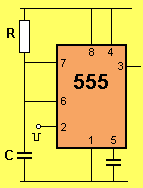 Monostable
Astable * Free-Running
Monostable
Astable * Free-RunningWhat is the name of the pin that activates a 555 in Delay mode:
- Control
- Trigger
- Discharge
- Threshold
Identify the output waveform produced by the following circuit:

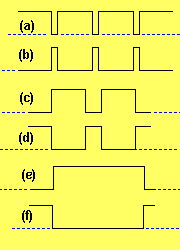 (a)
(b)
(c)
(d)
(e)
(f)
(a)
(b)
(c)
(d)
(e)
(f)Identify the output waveform produced by the following circuit:


(a) (b) (c) (d) (e) (f)Identify the output waveform produced by the following circuit:
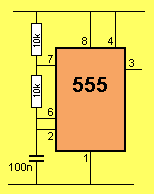
 (a)
(b)
(c)
(d)
(e)
(f)
(a)
(b)
(c)
(d)
(e)
(f)If the trigger-pulse in Q34 is held LOW longer than the delay produced by R and C, the output will:
- Stay LOW
- Stay HIGH
- Go LOW after the Delay and remain LOW
- Go LOW after the Delay for an instant, then go HIGH
Will the following circuit work?
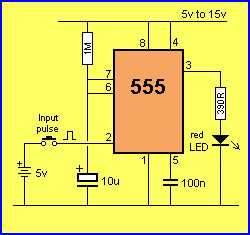 Yes
No
A resistor must be connected between pin 2 and 0v rail
Yes
No
A resistor must be connected between pin 2 and 0v rail
A resistor must be connected between pin 2 and the positive rail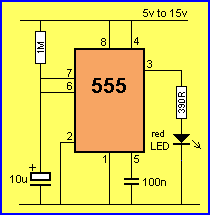
- The circuit will settle with the LED on
- The circuit will settle with the LED off
- The circuit will oscillate at a high frequency
- Unable to be determined
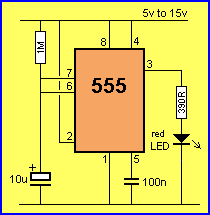
- The circuit will settle with the LED on
- The circuit will settle with the LED off
- Unable to be determined
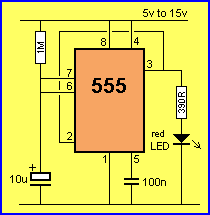
- The circuit will settle with the LED on
- The circuit will settle with the LED off
- The circuit will oscillate
- Unable to be determined
Quick Links
Legal Stuff
Social Media


